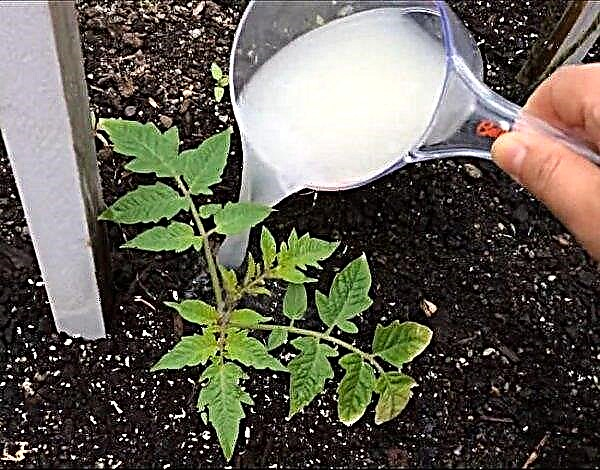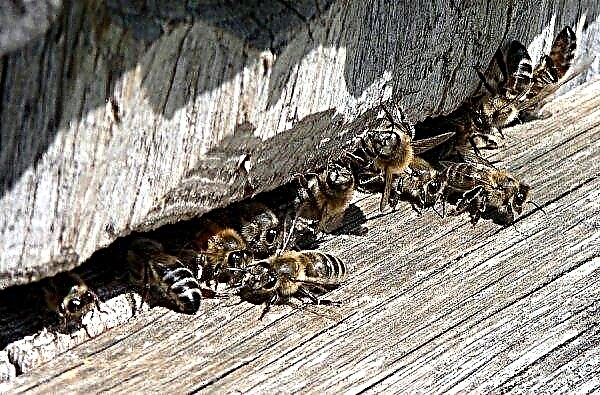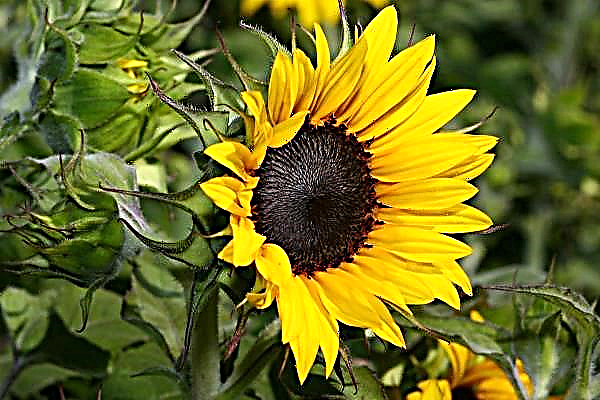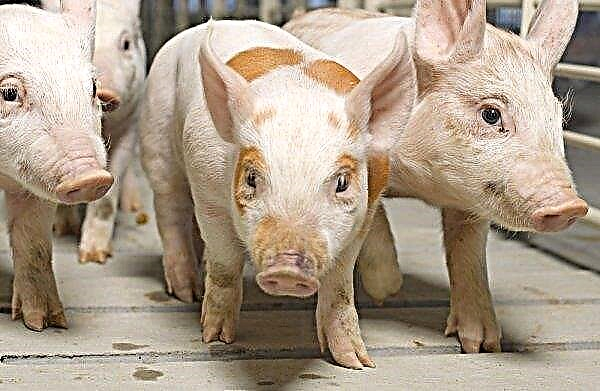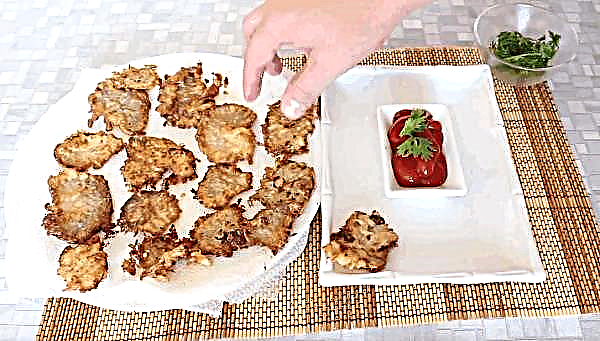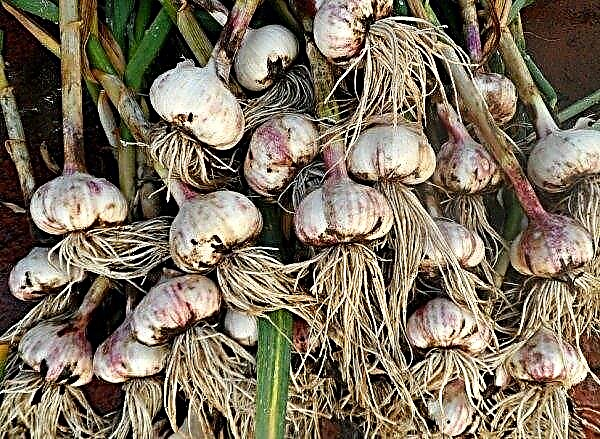If you are not the type of people who like to mess around for a long time on weekends in a garden but still want to have a healthy green lawn, there are several lawn mixtures and basic care steps that will help make the grass cover beautiful and well-groomed without too much difficulty. The article introduces the concept of "lawn for the lazy", with the choice of herbal mixtures, the rules of sowing and further care.
What is lawn grass for the lazy
Imagine grass that you never need to mow, water, it does not decay, does not dry out, does not change color in the sun. In winter, it looks the same as in summer, and is completely resistant to weeds. This is a description of the ideal grass that many grassland owners dream of in a garden.

Today, special herbal mixtures have been developed that allow you to approach the ideal and grow grass, which does not require active participation and large time spent on care. Often, gardeners call it "grass for the lazy" or "lazy lawn."
Did you know? Every 100 m² of lawn generates enough oxygen per year for 10 people to breathe, as well as increase atmospheric humidity and cool it.
The composition of the mixture of seeds
The lawn seems to be the simplest form of garden decoration, but contrary to the "simple" appearance, this is not the most elementary decision, because getting a good green lawn requires a lot of work, and it is almost impossible to grow it on very light soils and in shady places.
But today, thanks to the work of breeders and lawn specialists, many types of herbaceous plants have been obtained that do not require intensive care and complement each other when sown together. Therefore, even unskilled gardeners without any difficulty can create a truly charming green lawn.

There are about a dozen different herbs, and the “lazy lawn" contains mixtures of them. On sale you can find lawn products of domestic and foreign production ("Liliput", "Canada Green", "DLF Trifolium", "Sloth", "Sunshine", "Sun"). All of them contain, basically, the same plant seeds, taken only in different ratios.
- Optimally selected mixtures:
- provide rapid development and intensive growth of grass after sowing;
- create a dense turf that prevents the spread of weeds;
- differ in high winter hardiness and drought resistance;
- do not require the introduction of large quantities of nitrogen fertilizers, since the plants themselves accumulate nitrogen in the soil, such as clover;
- resistant to mechanical stress and disease.
Did you know? By their biological characteristics, palm trees are classified as very tall grass, but because of their size they are called trees..
The composition of the lawn grass for the lazy includes the following plant species:
- fescue (red modified, red Mystic, hairy, sheep's reed) - all species are very finely textured, with needle tips up to 1.5 mm wide, color - matte or gray-green, soft, grow quickly, withstand shading, do not tolerate heat and dry conditions, plants of a cool and warm season;

- bluegrass meadow compact - has a deep green color and excellent soft texture, grass width 3 mm; grows well from seeds, forming an extensive system of rhizomes and underground stems that sprout new plants, but does not tolerate shading, cold season culture;

- ryegrass perennial capri - grows quickly, in bunches, leaves a whitish hue when mowing, shiny and peaked blades of grass are dark green and soft, 3 mm wide, can tolerate heavy pedestrian loads, but cannot withstand extreme cold or drought, water demand is average;
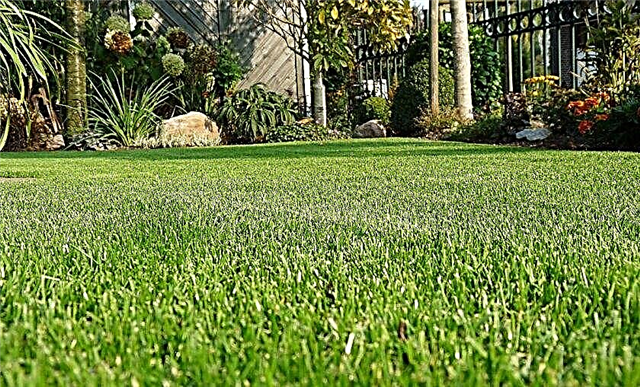
- clover white - perennial flowering plant with creeping stems that can root; it is resistant to trampling and after mowing it grows back quickly, the leaves are light green, consist of three segments, each of which has a white horseshoe-shaped pattern on the upper side;
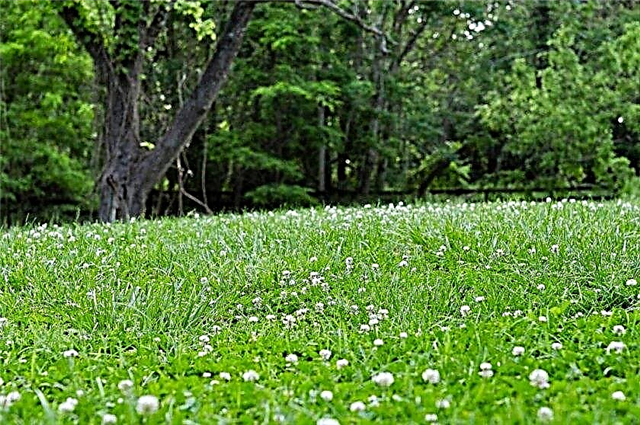
- field trees (sprouting and thin) - narrow and flat grass, texture - soft and dense, width 3 mm, requires frequent watering, plants of the cool season.

When stored in a cool, dry place, grass seeds can be stored for 2–3 years. However, germination and germination rate decrease over time, so you may not get the same results as when using fresh seeds. For best results, use fresh planting material and try to plant it throughout the year.
Important! It is not recommended to plant new grass within 2–4 months after using weed control agents on the site.
Rules for planting and caring for grass
First you need to draw a diagram of the future lawn, take into account the location of trees, shrubs, flower beds, footpaths and other landscape elements so that they do not interfere with grass mowing. According to the scheme, you can estimate the area of the future lawn, which is useful for determining the norms of sowing seeds and fertilizing.

It is best to plant a new lawn in spring or early fall when the soil is wetso that the grass has good conditions for engraftment in a new place. The fall season combines warm soil and cool air, which is ideal for sowing seeds and gives time for the development of new roots before winter.
Choose seeds that suit the climatic conditions of your area. Herbs of the warm season are planted in the southern regions. And the cold season grasses better cope with extreme temperature fluctuations in the north, northeast and northwest. Despite the fact that mixtures of herbs are called a “lawn for the lazy,” some care for the green meadow is necessary, although minimized.
Site preparation and sowing
The site is thoroughly cleaned of stones, the remains of shrubs, roots and weeds (especially perennial ones), the site is leveled so that there are no hills and hollows. The smoother the surface, the easier it will be to look after it. To improve the structure of the soil and enrich it with humus, make compost, overripe manure or garden peat in the amount of 30–40 kg per 10 m².
Heavy loamy soils can be adapted to the conditions of grass growth by adding sand or fine gravel to them. Clay and humus-rich soil (compost, peat) improves the structure of lighter sandy soils. Slow-release multicomponent mineral fertilizers with a predominance of phosphorus and potassium (potassium monophosphate) in the amount of 0.4 kg per 10 m² can also be added.

Preparation is carried out as early as possible - 1-2 weeks before sowing the seeds so that the soil has time to settle naturally. Before sowing, the soil is carefully raked and loosened to remove plant debris. Sowing the seed in small areas can be scattered manually, in large areas it is better to do this with a seeder.
When sowing, clearly follow the rate of seed consumption, which is indicated on the package so that the sprouts have enough space for access to water and nutrients. The sowing place is covered with a soil layer of 1 cm and slightly crushed. This can be done with boards attached to shoes. Then the plot is watered. Try to keep children and pets away from the sowing area until the grass reaches 5–8 cm in height.

There are many factors that can prevent the successful germination of seeds on the lawn - too much or lack of water, weather conditions, the use of weed control products, inappropriate soil conditions. If difficulties arise in the construction of the lawn, it is necessary to consult with specialists.
Using straw to mulch newly sown areas is not recommended because it may contain weed seeds and other unwanted plants that fall on the lawn along with grass.
Watering
Proper watering is an important step towards successful sowing. It is necessary to keep the soil surface in a wet state, watering daily or as necessary until the height of the young shoot reaches at least 5 cm. Watering must be done carefully, by sprinkling, with a diffused stream of water and gradually so that a crust does not form on the soil and light seeds were washed out. It is advisable to do this in the morning or evening.

Grass seeds usually germinate after 7-14 days. After the lawn is formed and mowed at least once, watering intervals begin to be reduced to two times a week, saturating the soil well to a depth of 15–20 cm, where most of the roots of sod grass are located, but the formation of puddles should be avoided.
If watering is too weak and superficial, then the root system does not germinate deep enough, which leads to a decrease in drought tolerance in hot periods. Watering in the morning (before 10 am) is the best time for irrigation.
At this time it is still cool and not so windy, so water can be absorbed into the soil and absorbed by the roots before it evaporates. Watering in the evening is preferably carried out at 16-18 hoursto allow the grass to dry before dark to prevent the spread of fungal diseases.
However, it is worth noting that the "lazy lawn" does not have to be watered often - it is quite resistant to drought and can do without water for a week or more. After several days of drought, the grass loses its stiffness and changes color. If the lawn takes on a grayish tone or looks dull green, then it needs water.
 You can also check this: go along it - if the tracks do not disappear quickly, then the grass does not have elasticity to straighten.
You can also check this: go along it - if the tracks do not disappear quickly, then the grass does not have elasticity to straighten.
A haircut
As soon as the sowed lawn reaches the cutting height (8–10 cm), they begin to mow, cutting only the upper ends of the grass (1–2 cm). This contributes to the good development of the root system, the germination of new shoots, from which the grass cover will be denser and denser.
If you are cutting grass with a lawn mower or with scythes, it is very important that the blades are sharpened well before the first cut of the season. The dull edges of the tools can damage the grass, stretch poorly rooted plants from the lawn and form empty spaces in the meadow, which will provide an opportunity for weeds to grow and spread.
Cutting is carried out when the knives of the lawn mower are installed in the maximum position, which corresponds to 7–10 cm. The further frequency and nature of mowing depends on the growth rate of the grass, weather conditions, season, but in a season there should not be less than one mowing in 1-2 weeks. The intensity decreases closer to the fall, because at this time the growth rate of shoots decreases.
 Do not cut too often. This may harm the lawn.
Do not cut too often. This may harm the lawn.
Longer grass contributes to good root development, which is especially significant during droughts. In addition, if you live in an area where there is a lot of sunshine or heat, a longer shoot can prevent burnout and brittle grass.
The first spring mowing is carried out when the cover grows by 7–10 cm, which will allow it to recover faster after the winter period. Periodically, the lawn should be cleaned with a rake, removing dirt, organic waste, leaves, garbage and grass left after mowing. For these purposes, specially profiled rakes should be used.
Important! Before using the weed control, it is recommended to wait until the new grass is trimmed more than 4 times.
An equally important procedure is lawn aeration to increase soil moisture and air permeability and more complete use of nutrients by plant roots. To do this, in the soil, forks pierce holes to the depth of the teeth (approximately 200 pits per 1 m²).
The best periods for aeration are summer or early autumn, although, if necessary, the event can be held in spring. The procedure is performed on ordinary grass once a year for lawns subject to high loads. In the case of decorative lawns, this is done every 2-3 years.

Fertilizer and fertilizing
6-8 weeks after planting a new grass, fertilizing begins regularly through high-quality fertilizers for lawns with a gradual release, which will provide the plants with the nutrients necessary for building strong roots. As a result, the grass will grow faster and thicker, and the stems look more powerful.
In early spring and late summer, a layer of compost soil about 1 cm thick can be thrown onto the plot. Fertilize the newly created lawn in spring, immediately after the first mowing. In this initial period, nitrogen fertilizers should be applied first of all, because it depends on them whether the lawn will be juicy and green (of course, with sufficient humidity). For fertilizer use ammonium nitrate (150 g per 10 m²), which can be manually distributed.
Early spring fertilizer is necessary because it aims to restore the lawn after winter, he needs a rich breeding ground to accelerate growth and grow green mass. There is still a lot of moisture during this period, and the grass has the possibility of rapid growth. On hot and dry days that begin in May, development ceases to be so intense.

Feeding is repeated in May and early summer (if necessary) with an interval of about 1.5–2 months. In the event of a drought, fertilizer should be discontinued. It is better to feed before the rain, so that the substances do not lie on the surface, or combine with watering.
Nitrogen fertilizers are last applied at the beginning of summer. Using them at a later time will negatively affect the wintering of the grass, causing intense growth. In autumn, fertilizers with a predominance of potassium are used. This will not only help in developing stronger and deeper roots before the onset of winter, but will also provide plants with nutrients to repair damage from summer heat, drought and trampling.
Phosphoric fertilizers are used only once, because they remain in the ground for several years. Fertilizing grass is not difficult, but it is necessary to achieve the intended goal - to create a beautiful and juicy lawn. Many special formulations are sold (Agrecol, Emerald Lawn, Pokon, Lawn, etc.) and are easier to use according to the doses recommended by the manufacturer.
Important! The choice of fertilizers should be treated with special care if small children play on the lawn and pets run around. When purchasing, check the safety of use with a specialist.
Update and subseeding
If bald spots have formed on the lawn or part of the site is mechanically damaged, then you should start updating the green cover and replanting grass:
- First, loosen the soil with a small rake, remove stones, the remains of the old grass and other possible plant debris, so that it is easier for young sprouts to strengthen and grow a full root system.
- Then apply a thin and even layer of seeds as indicated on the label if you are using purchased seed, and sprinkle a thin layer of soil on the planting site. No need to sow very densely, as the plants will grow.
- Now gently and thoroughly water until the applied layer of seeds and the soil under it are saturated and saturated with moisture, but do not let the water stagnate. Cover the area with non-woven material (it is removed when sprouts appear) so that the seeds do not dry out, are not washed out during irrigation and the birds did not glue them.
- Until the sprouts reach a height of 5 cm, water daily as needed to keep the soil and grass moist. The lack of water leads to yellowing and drying of the tender shoots.

Sometimes, to revitalize the lawn, just replanting is enough, which consists in simply scattering seeds on the existing lawn to thicken the grass cover. Over time, seasonal stresses such as heat, drought, winter conditions, walking wear and pests can lead to depletion and weakening of the grass.
Replanting is a quick and inexpensive way to return the lawn to a lush green color without digging the entire plot as in the initial planting and sowing. But if there is more “bare” soil or weeds on the plot than grass, it is better to start all over and reseed the lawn.
Did you know? The most expensive lawn is the central tennis court of Wimbledon, although used only 2 weeks a year. It has about 54 million annual herbaceous plants in its coating and requires constant careful care.
Choosing the right quality seeds and preparing the soil well, you can create a new lawn yourself. And with the proposed methods of sowing and caring for the green lawn, you will be less likely to mow, less water, never buy pesticides and have the best lawn in the garden.







